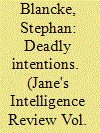|
|
|
Sort Order |
|
|
|
Items / Page
|
|
|
|
|
|
|
| Srl | Item |
| 1 |
ID:
190835


|
|
|
|
|
| Summary/Abstract |
Much ado has been made about the specter of unconventional weapons in the hands of militant groups. Despite the alarmism of the policy community, the pursuit of chemical, biological, radiological, and nuclear capabilities by non-state actors is rare. What explains why some violent non-state organizations pursue chemical, biological, radiological, and nuclear weapons while most do not? Using new data on organizational behaviors and attributes from the Big Allied and Dangerous 2 Insurgency project, we analyze 140 insurgent actors, from 1998 to 2012. We expand previous work by Asal, Ackerman & Rethemeyer by studying the phenomenon longitudinally and attending to organizational behavior rather than only to structural and environmental factors. We find that organizations that attack cultural sites are more likely to pursue and use chemical, biological, radiological, and nuclear weapons. We interpret the latter as a willingness to transgress upon accepted mores, for the sake of sensationalism and shock value, which coheres with a willingness to pursue unconventional weapons. Our results reflect that chemical, biological, radiological, and nuclear pursuit and use is part of a larger strategy for some violent non-state organizations, one predicated on generating mass fear and exacting a psychological toll.
|
|
|
|
|
|
|
|
|
|
|
|
|
|
|
|
| 2 |
ID:
110855


|
|
|
|
|
| Publication |
2012.
|
| Summary/Abstract |
Despite plentiful scholarship relating to the prospect of terrorists utilizing chemical, biological, radiological, or nuclear (CBRN) weapons, little of this work is both quantitative in nature and global in scope. Leveraging open-source data, this study quantitatively explores factors influencing the terrorist organizational decision to pursue CBRN weapons. The findings suggest that organizations embedded in alliance structures and based in authoritarian countries with relatively strong connections to a globalized world are more likely to seek to develop or acquire CBRN weapons. Contrary to previous qualitative studies, the present study failed to find a significant relationship between CBRN pursuit and religious ideology.
|
|
|
|
|
|
|
|
|
|
|
|
|
|
|
|
| 3 |
ID:
173086


|
|
|
| 4 |
ID:
191516


|
|
|
|
|
| Summary/Abstract |
What factors affect the likelihood that violent nonstate actors pursue and use chemical, biological, radiological, or nuclear (CBRN) weapons? What factors make a country at-risk for a CBRN terrorist attack? We argue that widespread repressive practices, also termed human rights abuses, are especially problematic in the fight to stop the pursuit or use of CBRN weapons. Repression by government forces severs ties between civilians and their government, leading those with knowledge of attacks to refrain from turning over necessary information. We test our argument quantitatively using data from the Big Allied and Dangerous Project and the Global Terrorism Database. Our results highlight how efforts taken to limit the use of repression may be an effective strategy to reduce risks of CBRN terrorism.
|
|
|
|
|
|
|
|
|
|
|
|
|
|
|
|
|
|
|
|
|